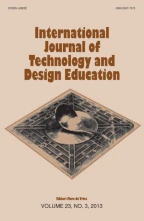Abstract
This paper puts the case for using a pedagogical framework based on the principles of grammatical design in conjunction with conventional creative problem solving strategies in higher education to foster learning for innovation and creativity. It explores the design and delivery of an inaugural creativity and innovation course that used a combination of individual and group projects to explore the combinatorial use of creative problem solving strategies and grammatical design schemas. Using established creative thinking evaluation techniques and reflective practice journals offers a powerful path for the creative development of innovative ideas. Testing (Torrance, Creativity in the classroom, 1977) found that the figurative based creative thinking scores of an experimental group of non-designer undergraduate students significantly improved according to pre and post course tests. Two dimensional and three dimensional design assessment tasks were completed in conjunction with a series of creative problem solving teamwork sessions. Standard SELTS course evaluation also strongly suggests there is value in the active teaching of creativity strategies for the recognition of valuable problems and the development of innovative solutions.
Similar content being viewed by others
Explore related subjects
Discover the latest articles, news and stories from top researchers in related subjects.References
About.com. (2009). Symmetrical balance. Retrieved July 29, 2009, from Desktop publishing: Principles of design: http://desktoppub.about.com/od/designprinciples/l/aa_balance1.htm.
Adair, J. (2009). Leadership for innovation. London: Kogan Page.
Adams, J. L. (1990). Conceptual blockbusting: A guide to better ideas. New York: Basic Books.
Axelrod, A. (2008). Edison on innovation. San Francisco: John Willey & Sons.
Brown, K. (1997, March). IEEE expert: Intelligent systems and their applications archive. Retrieved December 11, 2008, from ACM Portal: http://portal.acm.org/citation.cfm?id=630215#abstract.
Bruton, D. (2008, July 30). New media pipelines: The introduction of new media to art, architecture and design culture. Retrieved December 11, 2008, from Journal of New Media and Culture: http://www.ibiblio.org/nmediac/summer2008/new_media_pipelines.html.
Chomsky, N. (2006). Language and mind. New York: Cambridge University Press.
Coyne, R. (1995). Designing information technology in the postmodern age. Cambridge Mass: MIT Press.
Crammond, B. (2002, Fall). Critique on the torrance tests of creative thinking: Figural forms A and B. Retrieved July 29, 2009, from Kyung-Hee Kim’s World of CREATIVITY: http://kyunghee.myweb.uga.edu/portfolio/review%20of%20ttct.htm.
Csikszentmihalyi, M. (1966). Creativity: The work and lives of 91 eminent people. New York: Harper Collins.
Davis, G. A. (1986). Creativity of forever. Dubuque, Iowa: Kendall/Hunt.
De Bono, E. (1972). Po: A device for successful thinking. New York: Simon & Schuster.
De Bono, E. (2008). Creativity workout: 62 exercises to unlock your most creative ideas. Berkeley, CA: Ulysses Press.
De Bono, E. (2009, January 19). Idea creativity. Retrieved July 29, 2009, from Edward De Bono web site: http://www.edwdebono.com/debono/msg22u.htm.
Dottore, A. (2006, July). New ECIC director appointed. Retrieved July 29, 2009, from mEdea: http://www.vision6.com.au/em/message/email/view.php?id=84639&u=675.
Eno, B. (2009, 4 3). Call out. Retrieved 7 29, 2009, from Panopticist: http://www.panopticist.com/2009/03/brian_eno_on_creativity_and_restraints.php.
Eno, B. (2009, May 26). Sydney Opera House’s white sails turn into giant canvas for spectacular light display. Retrieved 7 28, 2009, from Mail Online: http://www.dailymail.co.uk/news/worldnews/article-1188229/Sydney-Opera-Houses-white-sails-turn-giant-canvas-spectacular-light-display.html.
Felix, K. (n.d.). Artwork gallery. Retrieved July 29, 2009, from Rube Goldberg: http://www.rubegoldberg.com/.
Generative Design Centre at UTA. (2008). Toward a centre of generative design. Retrieved December 11, 2008, from Walter Stroup: http://www.edb.utexas.edu/faculty/wstroup/generative.htm.
Guilford, J. P. (1981). Frames of reference for creative behaviour in the arts. In J. C. Gowan (Ed.), Creativity: Its educational implications. Dubuque, IA: Kendall/Hunt.
Guilford, J. P. (1988). Some changes in the structure-of-intellect model. Educational and Psychological Measurement, 48, 1–4.
Hurson, T. (2007). Think better: An innovator’s guide to productive thinking. New York: McGraw-Hill Professional.
Kelly, T. (2001). The art of innovation. New York: Doubleday.
Kerle, R. (2009, 6 24). Ralph Kerle, Executive Chairman of The Creative Leadership Forum interviews Professor Roy Green, Dean, Faculty of Business, University of Technology, Sydney. Retrieved 7 29, 2009, from The Creative Leadership Forum: http://www.thecreativeleadershipforum.com/clf-interviews/2009/6/7/ralph-kerle-executive-chairman-of-the-creative-leadership-fo.html.
Lawson, B. (1990). How designers think. London: Butterworth Architecture.
Lumsdaine, E., & Binks, M. (2007). Entrepreneurship: From creativity to innovation. Oxford, UK: Trafford.
Michalko, M. (2006). Thinkertoys, Berkely. Toronto: Ten Speen Press.
O’Connor, A. (2008, 4 16). Innovation and entrepreneurship program sequence. Retrieved 7 29, 2009, from The University of Adealide: http://www.ecic.adelaide.edu.au/programs/entrepreneur/gradcert_socialent.pdf.
OODEsign. (2008). OODEsign—object oriented design. Retrieved December 11, 2008, from Object Oriented Design: http://oodesign.com.
Osborne, A. F. (1963). Applied imagination. New York: Scribner.
Oxman, R. (2006). Theory and design in the first digital age. Design Studies, 27(3), 229–265.
Oxman, R. (2008). Digital architecture as a challenge fordesign pedagogy: Theory, knowledge, models and medium. Design Studies, 29(2), 102–103.
Oxman, R., Radford, A., & Oxman, R. (1987). The language of architectural plans: In which principles elements and operations of architectural planning are explored using computer graphics as a planning sketchbook. Red Hill ACT: Royal Australian Institute of Architects.
Parnes, S. J. (1978). Can creativity be increased? In G. A. Davis (Ed.), Training creative thinking. Melbourne, FL: R E Kreiger.
Rowe, C. (1987). Design thinking. Cambridge Mass: MIT Press.
Scholastic Testing Service. (1990). Torrance tests of creative thinking. Bensenville, IL: Scholastic Testing Services.
Scott, R. G. (1951). Design fundamentals. New York: McGraw-Hill.
Simonton, D. K. (1998). Creativity from a historiometric perspective. In R. J. Sternberg (Ed.), Handbook of creativity (p. 124). Cambridge, UK: Cambridge University Press.
Stiny, G. (2006). Shape: Talking about seeing and doing. Cambridge, MA: The MIT Press.
Torrance, E. P. (1977). Creativity in the classroom. Washington, DC: National Education Association.
Ward, T. B. (2004). Cognition, creativity, and entrepreneurship. Journal of Business Venturing, 19, 173–188.
Wilde, J., & Wilde, R. (2000). Visual literacy: A conceptual approach to graphic problem solving. New York: Watson-Guptill.
Williams, A. (1999). Creativity invention & innovation. St Leonards, NSW: Allen & Unwin.
Wilson, L. M., & Corpus, D. A. (2001, September). The effects of reward systems on academic performance. Retrieved July 29, 2009, from National Middle School Association: http://www.nmsa.org/Publications/MiddleSchoolJournal/Articles/September2001/Article10/tabid/410/Default.aspx.
Author information
Authors and Affiliations
Corresponding author
Rights and permissions
About this article
Cite this article
Bruton, D. Learning creativity and design for innovation. Int J Technol Des Educ 21, 321–333 (2011). https://doi.org/10.1007/s10798-010-9122-8
Published:
Issue Date:
DOI: https://doi.org/10.1007/s10798-010-9122-8
